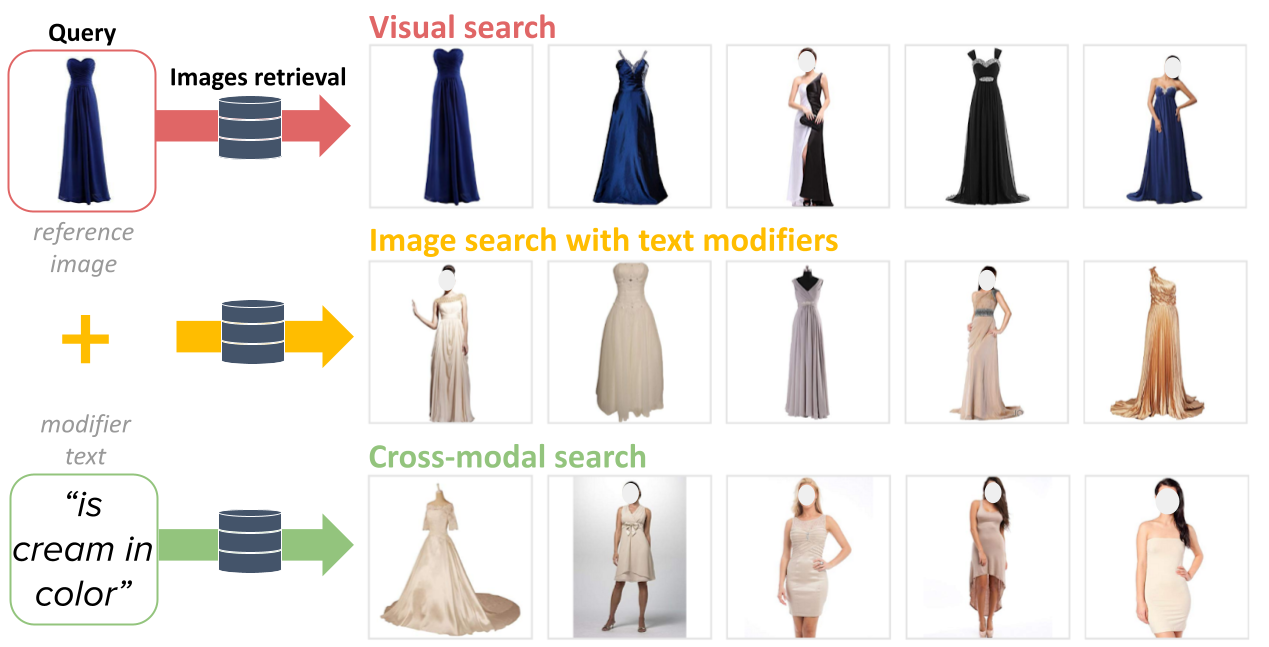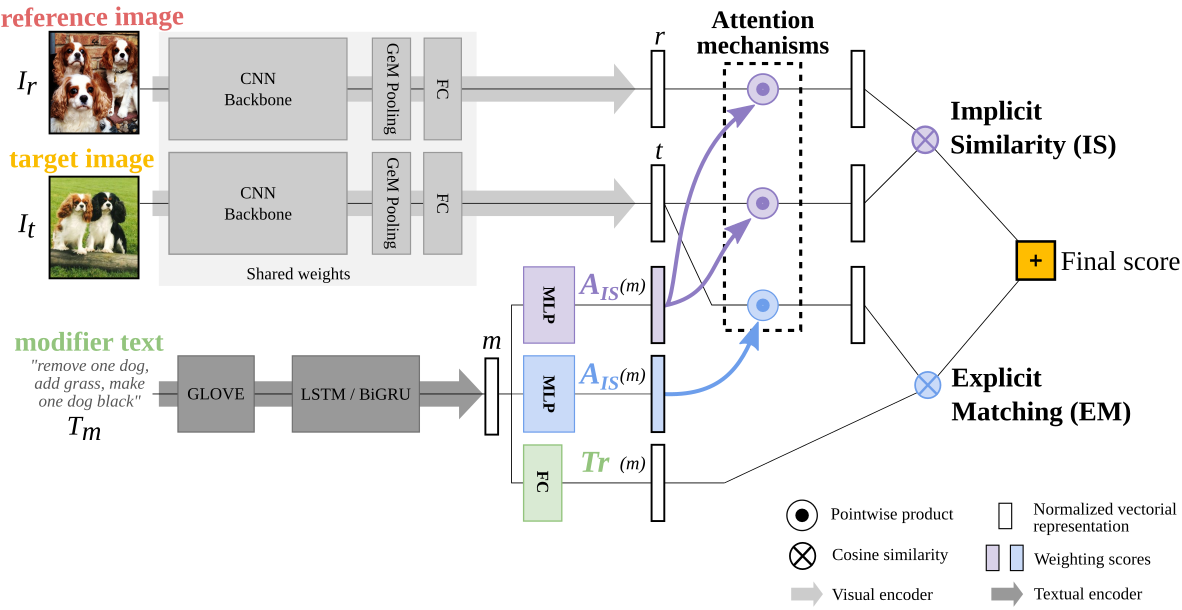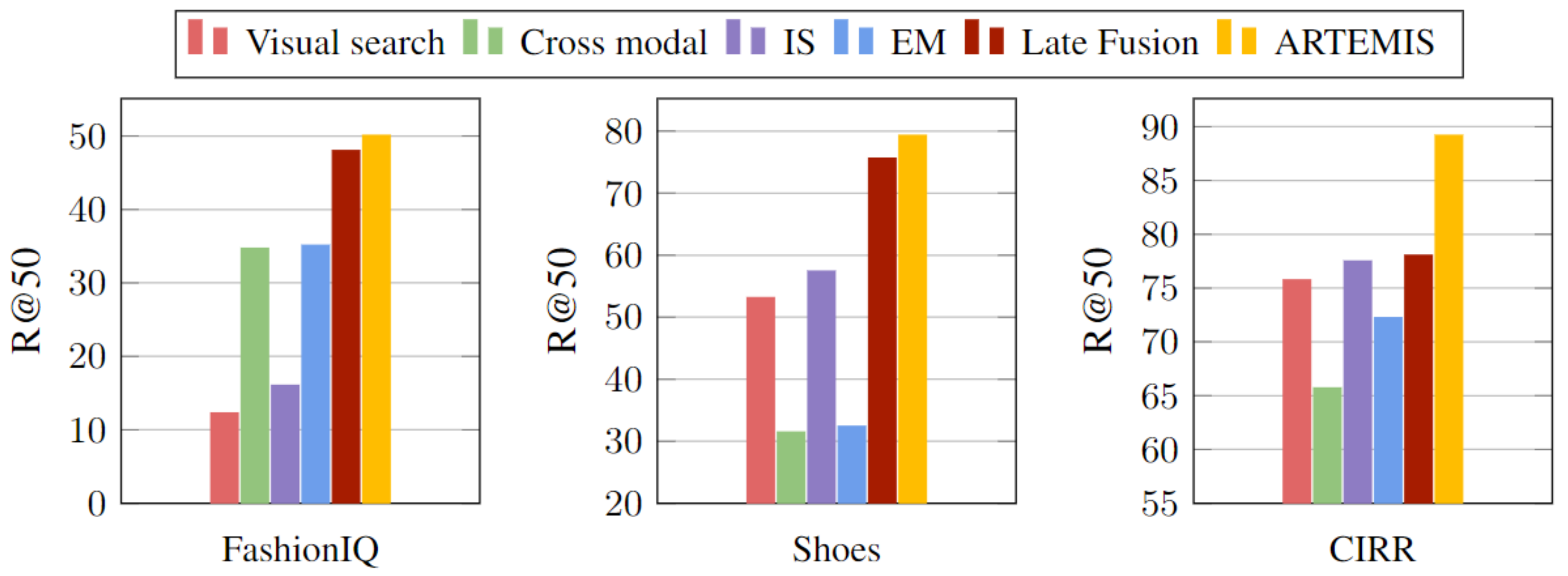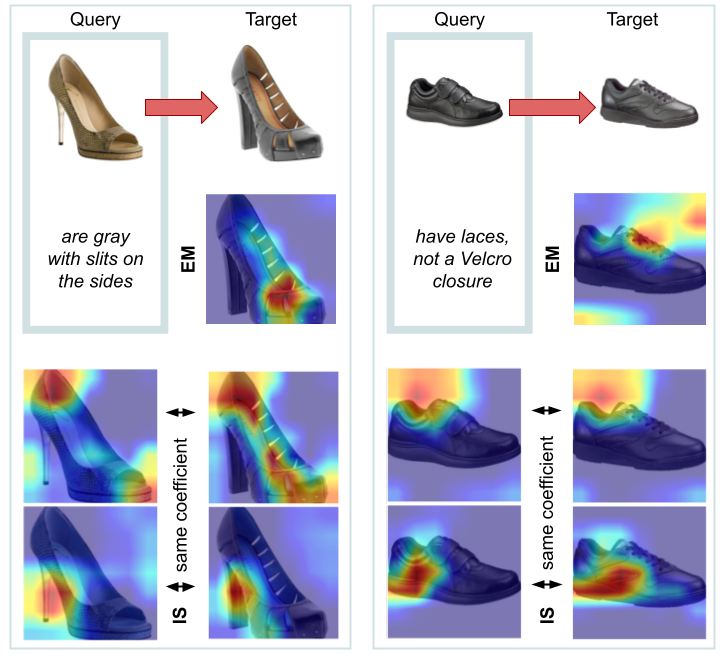This repository contains the code release of ARTEMIS, from our paper:
ARTEMIS: Attention-based Retrieval with Text-Explicit Matching and Implicit Similarity Ginger Delmas, Rafael Sampaio de Rezende, Gabriela Csurka, Diane Larlus, ICLR 2022. [Project page]
If this code and/or paper is useful in your research, please cite:
@inproceedings{delmas2022artemis,
title={ARTEMIS: Attention-based Retrieval with Text-Explicit Matching and Implicit Similarity},
author={Delmas, Ginger and Rezende, Rafael S and Csurka, Gabriela and Larlus, Diane},
booktitle={International Conference on Learning Representations},
year={2022}
}This code is distributed under the CC BY-NC-SA 4.0 License. See LICENSE for more information.
We address the problem of image search with free-form text modifiers, which consists in ranking a collection of images by relevance with respect to a bi-modal query: a reference image and a modifier text.
Current approaches typically combine the features of each of the two elements of the query into a single representation, which can then be compared to the ones of the potential target image.[1,2,3]
Departing from these strategies, we draw inspiration from two fields related to the task, cross-modal and visual search, and we advocate for a combination of the two components of the query taking into account their relationships with the target image. Each field is represented by an independent module in ARTEMIS. Our Explicit Matching (EM) module measures the compatibility of potential target images with the textual requirements and our Implicit Similarity (IS) module considers the relevance of the target images with respect to the properties of the reference image implied by the textual modifier. Both modules are trained jointly by a contrastive loss.
Create the environment for running our code as follow:
conda create --name artemis python=3.8.12
conda activate artemis
pip install -r requirements.txt
Note: using cuda version 10.2 (please modify requirements.txt otherwise)
You need to modify the values of some variables in config.py to adapt it to your system and preferences:
MAIN_DIR: where to store data & results (default root for vocabulary files, model checkpoints, ranking files, heatmaps...); it should also be defined at the beginning ofrelease_script.sh. This is default to the main directory of this code repository (ie. the parent directory ofconfig.py).TORCH_HOME,GLOVE_DIR: where ImageNet's pretrained models (resnet50/resnet18) weights and GloVe vectors (glove.840B.300d.txt.pt) are stored, locally on your machine<dataset>_IMAGE_DIR(with<dataset>one ofFASHIONIQ|SHOES|CIRR|FASHION200K): where to find the images of the different datasets (see next section)<dataset>_ANNOTATION_DIR(idem): where to find the annotations (basically triplet & split information) for the different datasets.
After downloading the datasets you wish to use at your preferred location, please register associated paths in config.py.
FashionIQ [4]: Please refer to the FashionIQ repo for the list of image URLs, train-test-val splits (/image_splits folder) and train/validation candidate-captions-target triplets (/captions folder).
As of time of writing, as many image URL are broken, a link to the FashionIQ images can be found here, or at the CosMo repo. We note that we do not have the license to release the FashionIQ test set annotations. Please contact the FashionIQ authors to obtain them.
Shoes [5]: Download the images of [6] at their webpage and the annotations of [5] from the corresponding repo. Our code assumes Shoes data is in a similar format as FashionIQ. Please run the following to run our code with Shoes data: python prepare_data/prepare_shoes_data.py.
CIRR [7]: Please check out the CIRR repo for instructions. Notice that most of the raw images are no longer available due to broken links. We follow the author's instructions and use the pre-extracted ResNet152 features (trained on ImageNet) as a replacement to the images.
For an evaluation on test split CIRR, our code produces a .json file compatible to the instructions of Test-split Server on CIRR Dataset
Fashion200K [8]: Please check out the Fashion200K repo for instructions on how to download the images and the TIRG repo for downloading their generated test queries.
After downloading the annotations of a dataset, you can compute the corresponding vocabulary by running:
python vocab.py --data_name <dataset>
You should obtain the following vocabulary size for the different datasets:
- FashionIQ: 3775
- Shoes: 1330
- CIRR: 7101
- Fashion200K: 4963
sh ./scripts/release_script.sh eval <model> <dataset>
<model>: can be selected fromARTEMIS|TIRG|cross-modal|visual-search|late-fusion|EM-only|IS-only.<dataset>: can be selected fromfashionIQ|shoes|cirr|fashion200k.
For CIRR, our evaluation script also produces json files compatible with the dataset's evaluation server.
Similarly to the evaluation code, simply run:
sh ./scripts/release_script.sh train <model> <dataset>
Run the following to generate 3 heatmaps per coefficient of each score (EM & IS), for 5 data examples yielding good recall results (you can optionally change this setting through some global parameters defined at the top of generate_heatmaps.py):
sh ./scripts/release_script.sh heatmaps <model> <dataset>
This will produce several images and a metadata text file, in a specific directory created for each considered data example. Specifically:
-
EM_coeff_<coeff_index>_on_trg_heatmap.jpgcorresponds to the heatmap for the<coeff_index>-th EM coefficient, shown on the target image (the EM score does not involve the reference image). -
IS_coeff_<coeff_index>_on_<image>_heatmap.jpgcorresponds to the heatmap for the<coeff_index>-th IS coefficient, shown on the<image>image (<image>takes each one of"trg"|"src", for the target or the reference image respectively). -
metadata.txthas one row for each of the selected relevant coefficients, with the following format:<data_example_index>*<IS|EM>_coeff_<coeff_index>*<score_contribution_value>eg.421*IS_coeff_472*0.0815or421*EM_coeff_37*0.0226for data example 421.and a last row giving the identifiers for the involved images and the corresponding modifier text:
<data_example_index>*<modifier_text>*<reference_image_identifier>*<target_image_identifier>eg.421*have laces, not a Velcro closure*womens/womens_athletic_shoes/1/img_womens_athletic_shoes_1343.jpg*womens/womens_athletic_shoes/0/img_womens_athletic_shoes_971.jpg
Additionally run:
pip install ptflops
Then:
sh ./scripts/release_script.sh ptflops <model> fashionIQ
This script will output the number of GMacs (for a given fixed input) and the number of trainable parameters of <model>, similar to what we present in Table 7 of our ICLR paper.
[1] Nam Vo, Lu Jiang, Chen Sun, Kevin Murphy, Li-Jia Li, Li Fei-Fei, and James Hays. Composing text and image for image retrieval-an empirical odyssey. CVPR 2019.
[2] Yanbei Chen, Shaogang Gong, and Loris Bazzani. Image search with text feedback by visiolinguistic attention learning. CVPR 2020.
[3] Seungmin Lee, Dongwan Kim, and Bohyung Han. Cosmo: Content-style modulation for image retrieval with text feedback. CVPR 2021.
[4] Hui Wu, Yupeng Gao, Xiaoxiao Guo, Ziad Al-Halah, Steven Rennie, Kristen Grauman, and Rogerio Feris. Fashion IQ: A new dataset towards retrieving images by natural language feedback. CVPR 2021.
[5] Xiaoxiao Guo, Hui Wu, Yu Cheng, Steven Rennie, Gerald Tesauro, and Rogerio Feris. Dialog-based interactive image retrieval. NeurIPS 2018.
[6] Tamara L. Berg, Alexander C. Berg, Jonathan Shih. Automatic Attribute Discovery and Characterization from Noisy Web Images. ECCV, 2010
[7] Zheyuan Liu, Cristian Rodriguez-Opazo, Damien Teney, and Stephen Gould. Image retrieval on real-life images with pre-trained vision-and-language models. ICCV 2021.
[8] Xintong Han, Zuxuan Wu, Phoenix X Huang, Xiao Zhang, Menglong Zhu, Yuan Li, Yang Zhao, and Larry S Davis. Automatic spatially-aware fashion concept discovery. ICCV 2017.



